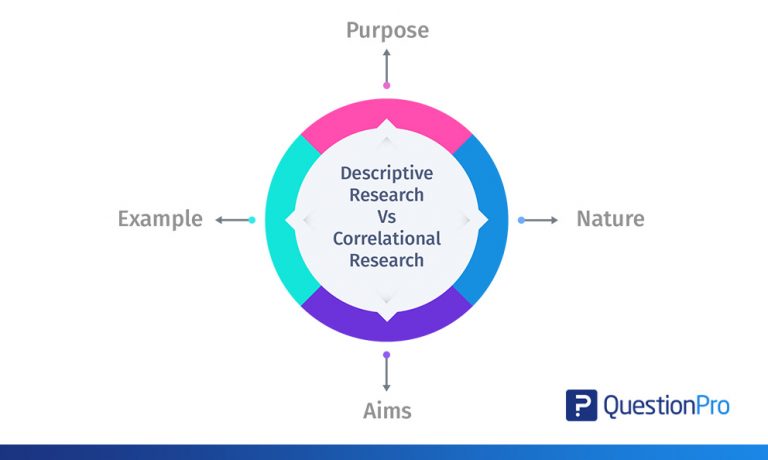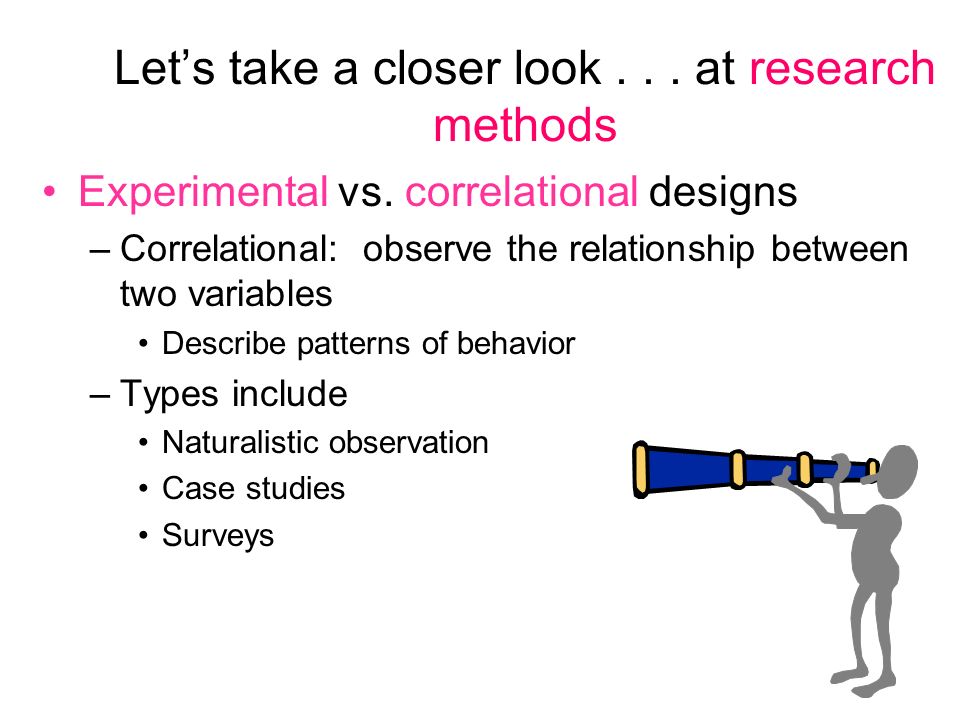In correlational studies a researcher looks for associations among naturally occurring variables whereas in experimental studies the researcher introduces a change and then monitors its effects. In correlational research the researcher looks for a statistical pattern linking 2 naturally-occurring variables while in experimental research the researcher introduces a catalyst and monitors its effects on the variables.

Descriptive Research Vs Correlational Research Questionpro
Descriptive researchers create very detailed records and observe many subjects.

. One or more control groups one or more experimental groups random allocation to control and experimental groups. You can test whether your variables change together but you cant be sure that one variable caused a. A quasi-experimental study is a non-randomized study used to evaluate the effect of an intervention.
He merely records the values of variables. Correlational research is a non-experimental method of studying the relationship between two variables using statistical analysis. The major difference between correlational research and experimental research is methodology.
There can be significant findings in each type of study. Importantly with correlational research you can examine only. Correlational research does not examine the effects of extraneous variables on the variables being studied.
The goal of experimental research design is to provide more definitive conclusions about the causal relationships among the variables in the research hypothesis than is available from correlational designs. Research designs can be classified into three major types in descending order of ability to determine causal relationships. Focus on difference between two groups.
Other variables are controlled so they cant impact the results. Researchers use the correlation to describe and measure the degree of association or how variables influence each other. Experimental studies allow the researcher to control the variables in the study while correlational ones involve just looking at the data that already exists.
Experimental designs quasi-experimental designs and non-experimental designs. An experimental design where treatments arent randomly assigned is called a quasi-experimental design. 5 we include some ciwtrols for.
Also correlational studies usually show a much weaker effect than experimental ones because of the effect of the many uncontrolled variables which are mixed into each individual instance. 4 we include specific procedures for testing hypotheses. Focus on magnitude and direction of relationship.
Here researchers do not intervene and change behavior as they do in experiments. Explore this article 1 Research Variables. Heres a table that summarizes the similarities and differences between experimental and quasi-experimental study designs.
What is the difference between Correlational and Experimental Research. A true experiment includes several key features. For example a nurse might test whether one nursing intervention works better than another.
Because a correlational study does not manipulate which variable precedes the other it cannot attribute causal direction to the relationship. Descriptive research is research designed to provide a snapshot of the current state of affairs. Quasi-experimental and experimental studies test interventions or independent variables presumed causes to see which most influences a dependent variable or presumed effect.
Correlational research is research designed to discover relationships among variables and to allow the prediction of future events from present knowledge. Descriptive Research use systematic observation to describe a specific behavior. Correlational Research allows researchers to relate variables rather than manipulate a variable in an experiment.
Quasi-experimental designs seek to discover whether an independent variable causes an effect on a dependent one. Explore quasi-experimental case studies and correlational research designs and recognize how they. Experimental Quasi-experimental and Non-experimental.
Correlational design simply investigates the relationship of one variable to another. Descriptive research cannot make predictions or determine causality. 2 we include at least two levels of the independent variable although we may not manipulate it.
A correlation is a test that determines the tendency or pattern for two or more variables to vary consistently. In a between-subjects design also known as an independent measures design or classic ANOVA design individuals receive only one of the possible levels of an experimental treatment. 3 we usually cannot assign subjects to groups but must accept existing groups.
The Difference between Descriptive Correlational and Experimental Studies. Experimental studies allow the researcher to draw conclusions about one variable causing changes in another. In correlational research there is no attempt made by the researcher to control or influence variables.
Thus in quasi-experimental designs. It is important to be able to distinguish between correlational and experimental designs because only well-controlled experimental designs allow conclusions about cause and effect. 1 we state a causal hypothesis.
In correlational research the goal is to identify patterns of relationships but not cause and effect. Correlational research establishes an association between and among variables and the number of variables is based on the study purpose and problem not what kind of study it is. In a correlational design you measure variables without manipulating any of them.
In an experimental research design the variables of interest are called the independent variable or variables and the dependent variable. Lets look at examples of all three types and how we diagram them. Research projects can be designed and conducted using different techniques and methodologies.
In a true experiment the investigator does two things. It is only experimental research that can establish a causal relationship between variables. In an experimental design you manipulate an independent variable and measure its effect on a dependent variable.
The intervention can be a training program a policy change or a medical treatment. Ad Browse Discover Thousands of Science Book Titles for Less.

Researcher S Spot Quantitative Approaches In This Module The Four Approaches To Quantitative Research Are Described And Examples Are Provided Learning Objectives List And Explain The Four Approaches To Quantitative Research Provide

Chapter 2 Psychological Science Descriptive Correlational And Experimental Research Designs Flashcards Quizlet

Correlational Vs Experimental Study Definition Types Design Examples

Correlational Research I Lawrence R Gordon Psychology Research Methods I Ppt Download

Connecting The Dots Our 1st Exposure To Research Studies Experimental And Confounding Variables Covered Between Within Experimental Research Designs Ppt Download

Comparing Descriptive Correlational And Experimental Studies Youtube

Scielo Brazil An Overview Of Research Designs Relevant To Nursing Part 1 Quantitative Research Designs An Overview Of Research Designs Relevant To Nursing Part 1 Quantitative Research Designs
3 2 Psychologists Use Descriptive Correlational And Experimental Research Designs To Understand Behaviour Introduction To Psychology 1st Canadian Edition
0 comments
Post a Comment